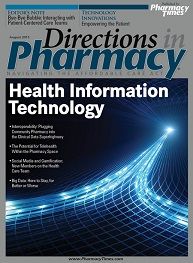Publication
Article
Pharmacy Practice in Focus: Oncology
Bye-Bye Bubble: Information Technology Puts Pharmacists at Risk of (Gasp!) Interacting with Patient-Centered Care Teams
Author(s):
A new technology paradigm is rapidly emerging that is the result of the combined effects of 2 trends: increasing consumerism and payment reform.
Health information technology (HIT) is a dry topic for many pharmacist practitioners, as it may have seemingly little relevance to everyday practice. Most of us have a pharmacy management system that gets us through the day, and it is focused on dispensing throughput and quality checks related to information generated by and contained within that pharmacy management or prescription order entry system. The exception, of course, being the ever-present electronic communications with payers in the community pharmacy and long term care settings.
Over the past few decades, major improvements in pharmacy HIT have been related mostly to efficient and effective (in terms of accuracy) prescription order generation and fulfillment through electronic prescribing and central-fill and high-volume automated dispensing, and efforts to meet the ever-increasing standards for facilitating the interaction between pharmacists and pharmacy benefit managers. These technical advances continue with the goal of improving the efficient and accurate dispensing of more than 4 billion prescriptions annually in the United States. However, a new technology paradigm is rapidly emerging that is the result of the combined effects of 2 trends: increasing consumerism and payment reform.
Trend #1: Consumerism
Consumers want it all, they want it now, and they want it on their terms. Have you ever wondered why it is so difficult to get someone on the phone? Instead of stopping what you are doing and spending time with the other person on the line on their time and cadence, the desired method of communication is often “Just text me...”
We have a love affair with texting, e-mail, and social media. Technologists believe that we prefer these forms of communication because they are available on our own schedule and allow us to shape the duration and nature of our interactions. In short, it puts us (the consumers) in complete control at all times of our own individualism and of how and when we share information with others. With the rise of the smartphone, these communications can continue wherever we go, which can mean corresponding via e-mail with colleagues while traveling or receiving a text from the pharmacy while shopping to let us know our prescription is ready.
Personal health records, fitness trackers, durable medical devices with continuous biofeedback, and health savings accounts are all about putting the consumer/patient in the center of their own care and, really, their own lives. The “I dictate to you what you do, when you do it, how it is done, and who should do it” model of care is rapidly eroding as consumerism penetrates health care. Practitioners of all types are moving away from doing things to patients and moving toward doing things with patients and their associated care team and caregivers.
Trend #2: Payment Reform
Arguably, the fundamental and overarching goal of health reform is population health management. Whether through transferring risk for quality and cost to providers, subsidizing and expanding coverage and access, or increasing price sensitivity through health savings accounts or incorporating patient incentives into benefit design, the health care system is slowly but surely evolving into a system of care—because it has no choice.
Population management is active, not passive. The old paradigm was to put up your sign out front and wait for patients to walk in your front door. The new paradigm is omnipresent engagement of an entire population whose cost and quality outcomes are your responsibility, regardless of their interaction with you as one of their providers of care. This new reality necessitates interacting with patients and their caregivers wherever they are, be it the discharge unit at hospital, in a clinic, or at their home. For community pharmacy, this is quite advantageous as the equivalent of the entire US population is in a pharmacy once a week (according to the American Pharmacists Association). This point of capture must be leveraged with a willing pharmacist service provider and that provider must be connected with the rest of the care team.
Bursting the Bubble
These 2 trends are shaping new investments and development in HIT that are focused on community- and system-wide care team coordination. Ultimately, this will force the practice of pharmacy out of its bubble and accelerate the movement away from product offerings (prescriptions and bubble gum) to service offerings (medication optimization services). We can no longer be siloed away from the rest of the health care system in both reimbursement and informatics. Success will be determined more by patient outcomes and less by rates of dispensing accuracy. We must assimilate with the new system of care, and HIT is the key to that assimilation.
Troy Trygstad, PharmD, PhD, MBA, is the director of the Network Pharmacist Program and Pharmacy Projects for Community Care of North Carolina (CCNC), a parent organization of 14 regional care management networks. These networks bring together medical practices, county health departments, hospital systems, and mental health providers to integrate care delivery for Medicaid, Medicare, private plans, employers, and the uninsured. CCNC and its networks are responsible for developing and evaluating accountable care systems in North Carolina. Under his direction at CCNC, the Network Pharmacist Program has grown to include pharmacists who are involved in a number of diverse activities including medication reconciliation, e-prescribing facilitation, and management of pharmacy benefits. He has also been involved in novel adherence implementations, as well as the development of adherence technologies that use administrative claims data to predict, intervene, and triage adherence interventions and coaching opportunities. Dr. Trygstad received his PharmD and MBA degrees from Drake University and a PhD in pharmaceutical outcomes and policy from the University of North Carolina. He is co-editor-in-chief of the Pharmacy Times series Directions in Pharmacy.







